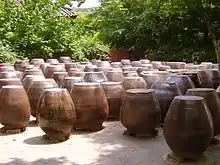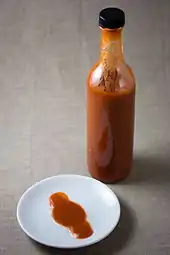.jpg.webp) | |
| Alternative names | Red chili paste |
|---|---|
| Place of origin | Korea |
| Associated cuisine | Korean cuisine |
| Main ingredients | Gochu-garu (chili powder), glutinous rice, meju-garu (fermented soybean powder) |
| Other information | HS code: 2103.90.1030 |
| Korean name | |
| Hangul | 고추장 |
|---|---|
| Hanja | 苦椒醬 |
| Revised Romanization | gochu-jang |
| McCune–Reischauer | koch'u-chang |
| IPA | [ko.tɕʰu.dʑaŋ] |
.jpg.webp) |
| This article is part of a series on |
| Korean cuisine 한국 요리 조선 료리 |
|---|
Gochujang (/ˈkɔːtʃuːdʒæŋ/)[1] or red chili paste[2] is a savory, sweet, and spicy fermented condiment popular in Korean cooking. It is made from gochu-garu (chili powder), glutinous rice, meju (fermented soybean) powder, yeotgireum (barley malt powder), and salt. The sweetness comes from the starch of cooked glutinous rice, cultured with saccharifying enzymes during the fermentation process.[3] Traditionally, it would be naturally fermented over years in jangdok (earthenware) on an elevated stone platform called jangdokdae in the backyard.
The Sunchang Gochujang Festival is held annually in Gochujang Village in Sunchang County, North Jeolla Province, South Korea.[4][5]
History
It has commonly been assumed that spicy jang (장; 苦椒醬) varieties were made using black peppers and chopi (Japanese pepper) before the introduction of chili peppers. Shiyi xinjian (食醫心鑑), a mid-9th century Chinese document, recorded the Korean pepper paste as 苦椒醬 (lit. 'pepper paste'). The second-oldest documentation of pepper paste is found in the 1433 Korean book Collected Prescriptions of Native Korean Medicines.[6] Pepper paste is again mentioned in a 1445 medical encyclopedia named Compendia of Medical Prescriptions.[7]
Chili peppers, which originated in the Americas, were introduced to East Asia by Portuguese traders in the early 16th century.[8][9][10] The first mention of chili pepper in Korea is found in Collected Essays of Jibong, an encyclopedia published in 1614.[11][12] Farm Management, a book from ca. 1700, discussed the cultivation methods of chili peppers.[13]
In the 18th-century books, Somun saseol (소문사설; 謏聞事說) and Revised and Augmented Farm Management, gochujang is written as gochojang, using hanja characters 苦椒醬 and 古椒醬.[14][15] It is also mentioned that Sunchang County was renowned for its gochujang production.[14] China and Japan, the countries with which Korea has historically shared the most culture and trade, do not include gochujang in their traditional cuisines.
Historical recipes
Gochujang ingredients reported in Jeungbo sallim gyeongje were 18 litres (19 US quarts) of powdered and sieved meju (fermented soybeans), 540 mL (18+1⁄2 US fl oz) of chili powder, and 1.8 L (1+7⁄8 U.S. qt) of glutinous rice flour, as well as soup soy sauce for adjusting the consistency.[15] The gochujang recipe in Gyuhap chongseo, an 1809 cookbook, uses powdered meju made from 18 L (19 US qt) of soybeans and 3.6 L (3+3⁄4 US qt) of glutinous rice, then adding 900–1,260 mL (30+1⁄2–42+1⁄2 US fl oz) of chili powder and bap made from 3.6 L (3.8 US qt) of glutinous rice.[16]
Ingredients

Gochujang's primary ingredients are red chili powder (고추가루; gochugaru), glutinous rice powder, powdered fermented soybeans, and salt. Korean chili peppers, of the species Capsicum annuum, are spicy yet sweet making them ideal for gochujang production.
Other recipes use glutinous rice (찹쌀; chapssal), normal short-grain rice (맵쌀; mepssal), or barley. Less common additions include whole wheat kernels, jujubes, pumpkin, and sweet potato. A small amount of sweetener, such as sugar, syrup, or honey, is also sometimes added. The finished product is a dark, reddish paste with a rich, piquant flavor.
The making of gochujang at home began tapering off when commercial production came into the mass market in the early 1970s. Now, most Koreans purchase gochujang at grocery stores or markets. It is still used extensively in Korean cooking to flavor stews (jjigae), such as in gochujang jjigae; to marinate meat, such as in gochujang bulgogi; and as a condiment for naengmyeon and bibimbap.
Gochujang is also used as a base for making other condiments, such as chogochujang (초고추장) and ssamjang (쌈장). Chogochujang is a variant of gochujang made by adding vinegar and other seasonings, such as sugar and sesame seeds. It is usually used as a sauce for hoe and hoedeopbap. Similarly, ssamjang is a mixture of mainly gochujang and doenjang, with chopped onions and other spicy seasonings, and it is popular with sangchussam (상추쌈).
Gochujang hot-taste unit
Gochujang hot-taste unit (GHU) is a unit of measurement for the pungency (spicy heat) of gochujang, based on the gas chromatography and the high-performance liquid chromatography of capsaicin and dihydrocapsaicin concentrations.[17]
Gochujang products are assigned to one of the five levels of spiciness: Mild, Slight Hot, Medium Hot, Very Hot, and Extreme Hot.[17]
| Extreme Hot | > 100 |
| Very Hot | 75–100 |
| Medium Hot | 45–75 |
| Slight Hot | 30–45 |
| Mild | < 30 |
Uses
Gochujang is used in various dishes such as bibimbap and tteokbokki, and in salads, stews, soups, and marinated meat dishes.[18] Gochujang may make dishes spicier (depending on the capsaicin in the base chili), but also can make dishes sweeter and smokier.
Further reading
- Erin Craig (19 Aug 2020). "Gochujang: The trendy Korean food that burns". BBC Travel. Retrieved 31 May 2023.
See also
References
- ↑ "gochujang". OxfordDictionaries.com. Oxford University Press. Archived from the original on April 16, 2017. Retrieved 15 April 2017.
- ↑ National Institute of Korean Language (30 July 2014). 주요 한식명(200개) 로마자 표기 및 번역(영, 중, 일) 표준안 (PDF) (in Korean). Archived from the original (PDF) on 23 January 2019. Retrieved 25 February 2017.
- 주요 한식명 로마자 표기 및 표준 번역 확정안 공지. National Institute of Korean Language (in Korean). 2014-05-02.
- ↑ "gochujang" 고추장. Doopedia (in Korean). Doosan Corporation. Retrieved 17 April 2017.
- ↑ "Sunchang Gochujang Village". Korea Tourism Organization. Retrieved 17 April 2017.
- ↑ "Sunchang Gochujang Festival". Korea Tourism Organization. Retrieved 17 April 2017.
- ↑ Kim, Soon-Hee; Chung, Kyung Rhan; Yang, Hye-Jeong; Kwon, Dae Young (2016). "Sunchang gochujang (Korean red chili paste): The unfolding of authenticity". Journal of Ethnic Foods. 3 (3): 201–208. doi:10.1016/j.jef.2016.09.002.
- ↑ Kwon, Dae Young; Chung, Kyung Rhan; Yang, Hye-Jeong; Jang, Dai-Ja (2015). "Gochujang (Korean red pepper paste): A Korean ethnic sauce, its role and history". Journal of Ethnic Foods. 2 (1): 29–35. doi:10.1016/j.jef.2015.02.006.
- ↑ Guide to Korean Culture: Korea's cultural heritage (2015 ed.). Seoul: Korean Culture and Information Service, Ministry of Culture, Sports and Tourism. 2015 [1995]. pp. 131–133. ISBN 9788973755714.
- ↑ Park, Jae Bok (Spring 1999). "Red Pepper and Kimchi in Korea" (PDF). Chile Pepper Institute Newsletter. Vol. 8, no. 1. p. 3. Retrieved 20 March 2017.
- ↑ Marianski, Stanley; Marianski, Adam (2012). Sauerkraut, Kimchi, Pickles & Relishes. Seminole, FL: Bookmagic. p. 45. ISBN 9780983697329.
- ↑ Hui, Y. H.; Ghazala, Sue; Graham, Dee M.; Murrell, K. D.; Nip, Wai-Kit, eds. (2004). Handbook of Vegetable Preservation and Processing. New York: Marcel Dekker. pp. 190–191. ISBN 978-0824743017.
- ↑ Yi, Sugwang. Jibong yuseol 지봉유설(芝峯類說) [Topical Discourses of Jibong] (in Korean). Joseon Korea – via Wikisource.
- ↑ Hong, Manseon. Sallim gyeongje 산림경제(山林經濟) [Farm Management] (in Literary Chinese). Joseon Korea. Archived from the original on 2017-03-28 – via DB of Korean classics by ITKC.
- 1 2 Yi, Sipil; Yi, Pyo (1940) [1722]. Somun saseol 소문사설(謏問事說) (in Literary Chinese). Joseon Korea.
{{cite book}}: CS1 maint: location missing publisher (link) - 1 2 Yu, Jungrim; Hong, Manseon (1766). Jeungbo sallim gyeongje 증보산림경제(增補山林經濟) [Revised and Augmented Farm Management] (in Literary Chinese). Joseon Korea.
- ↑ Yi, Bingheogak (1809). Gyuhap chongseo 규합총서(閨閤叢書) [Women's Encyclopedia] (in Literary Chinese). Joseon Korea.
- 1 2 National Agricultural Products Quality Management Service (September 2016). "Jeontong sikpum pyojun gyugyeok" 전통식품 표준규격 (PDF). Korean Standards & Certifications (in Korean). Korean Agency for Technology and Standards. pp. 88–89. Retrieved 17 April 2017.
- ↑ "Gochujang (Hot Pepper Paste)". visitkorea.org. Archived from the original on 2014-11-12. Retrieved 2013-04-19.
